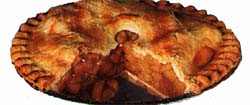|
|
Pies,
Pastries, Tarts & More

They
taste just like Grandma baked them - with tender flaky pastry
and an abundance of fresh-tasting filling. Keep your
fork...
There's Pie.
Rules for Using Dried Fruits for Pies:
Wash
the fruit thoroughly,
soak over night in water enough to cover. In the morning stew slowly
until
nearly done in the same water. Sweeten to taste. The crust, both upper
and under, should be rolled thin; a thick crust to a fruit pie is
undesirable.
Partly
Bake The Crust
When the
filling of the pie
you are preparing does not require so much baking as the crust, it is
good idea to bake the crust
partly before putting the filling in. This is particularly advisable
for the custard pies, jelly and preserved fruits pies. You can cover
them with whipped cream or meringue, that way you will not have to bake
the top crust shell.
If
the filling for your pie must be baked slowly, start the baking in a
very hot oven, so that the crusts
will have the benefit of the high temperature. Then the heat should be
gradually reduced until the filling will cook and the crust will not
burn.
Let
pies cool upon plates on which they were made because slipping them
onto cold plates develops moisture which always destroys
the crispness of the lower crust.
Browse Recipes:
|
|
Did You Know?
|
Pastry
is a shortened dough that is made of flour, water, salt, and
fat and used in the preparation of desserts. Chief among these deserts
are pies.
Pies are made by baking foods between two crusts of pastry or
with a single crust, which may be an upper or a lower one.
Originally
pies were not intended for desserts. Rather, they were used as the main
dish of the meal, as they contained a filling of meat or fish and
vegetables. Such pies are still made, but they are not usually the ones
intended when pastry for pies is mentioned.
Pies having one
crust usually contain a filling that consists of a custard mixture, a
mixture thickened with corn starch or flour, or occasionally a fruit
mixture. Some pies also have a top crust covering the filling, and when
this is the case a fruit filling, either fresh or cooked, is the kind
that is generally used.
Because of the nature of the materials usually used in the preparation
of
pies as desserts, the finished product is necessarily high in food
value.
When lemon juice is
sprinkled on certain foods that
tend to oxidize and turn brown after being sliced, such as apples,
bananas and avocados, the acid acts as a short-term preservative by
denaturing the enzymes that cause browning and degradation.
|
|